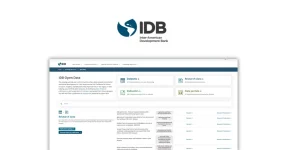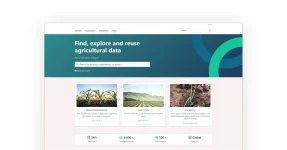A look at some of the key debates around Digital Public Infrastructure at the Open Government Partnership Summit 2025.
The following is the first of a series of articles on the Open Government Partnership Summit 2025, in Vitoria-Gasteiz, Spain, in early October. Link Digital had two staff on the ground throughout the Summit, Senior Solutions Architects Adrià Mercader and Technical Writer/Analyst Andrew Nette.

Senior Solutions Architects Adrià Mercader (right)
One of the key topics at the Open Government Partnership Summit 2025 was, what is digital public infrastructure (DPI) and can it play a role in reversing the erosion of trust between citizens and their governments?
Launched in 2011, the Open Government Partnership (OGP) is a global initiative to promote transparency, accountability and citizen participation in governance, as well as providing an international forum for governments and civil society to cooperate on changes to empower citizens. The 2025 Summit brought together more than 2000 participants to discuss a range of issues, including what was generally agreed to be the gradual fragmentation in the social contract between people and their governments.
Governments at all levels that attended the OGP Summit are feeling the pressures from this trend. This is where DPI could come into play. The digitisation of government services was seen by many of those present at the Summit as a potential way of heading off the erosion of citizen trust in official institutions, by enabling better and more citizen focused services.
The following article will examine DPI and some of the key conversations that took place around it.
The global state of digital public infrastructure
DPI refers to core digital systems that enable governments to function better and ensure that citizens, organisations and government entities can interact, exchange information and access services securely and easily.
A report from the London based Institute for Innovation and Public Purpose (IIPP), presented at the OGP Summit, has mapped the global uptake of DPI initiatives. The DPI Mapping Project aims to advance understanding of the state of DPI around the world by developing a baseline dataset on DPI initiatives and highlighting best practices around their development.
Undertaking a high-level scan of 210 countries, the mapping project identified three key areas in which DPI is being implemented:
- Digital identity systems: allow individuals to verify their identity once to access a range of government services, such as social welfare payments, healthcare, and education, etc.
- Digital payment systems: platforms that have a public interest operator that can facilitate real-time financial transactions.
- Data Exchange systems: digital systems that share data across sectoral/national levels, including ‘facilitating data sharing within government departments, to systems connecting multiple agencies and authorised third parties to share data crucial to public service delivery.’
According to Krisstina Rao, who presented the report on behalf of IIPP at the Summit, while there is still debate about what exactly DPI is, one clear finding that emerges from the research is that DPI “is more than about tech, it is also about good governance.” This means that DPI must be not only grounded in the operations of the state but include digital infrastructure that uses quality open data and that is transparent and inclusive.
The vital role of trust in implementing digital public infrastructure
Government representatives present at the OGP were bullish about the potential for DPI to reverse declining public dissatisfaction in government. This is because these digital interventions can directly improve the lives of citizens by solving key problems they face – such as providing a simplified one step form of digital identification to access government services.
But there are major problems in the way of successful DPI implementation.
In the past, “governments tried to develop digital infrastructure in a siloed way,” said Rao. “Each individual government department or agency had its own solution, which they have implemented themselves, using a different tech stack and authentication procedures.” The shift from a siloed to a collaborative approach that implements solutions that are interoperable across government is a key feature of DPI.
As part of their DPI, many governments are pursuing multi-stakeholder approaches, which involve civil society and the private sector. But this collaboration can be difficult, particularly when DPI initiatives attempt to involve non-government stakeholders with different perspectives.
One factor is different levels of digital interest on the part of the population, perhaps due to low levels of digital literacy and/or poor access to digital technology at the household level. Another factor that can negatively impact the design and rollout of DPI is low levels of trust in government. As one civil society representative put it: “In implementing DPI, is the government just asking the people for their information, i.e., biometric data or are we asking civil society for deeper input, for example, into the project design? DPI can work best when it is the latter track that governments go down.”
Yulita Mitei, deputy governor of the Kenyan state of Nandi, argued that public participation is crucial for the development of DPI platforms. Mitei discussed the recent roll out of a digital portal to manage all government procurement in Kenya, the design and roll out of which was significantly improved by the involvement of local civil society groups. “Public participation is crucial for the effective development of DPI platforms.”
Digital public infrastructure: the technology is far from neutral
Another major debate is around the choice of technology. While many OGP representatives were hopeful about DPI’s ability to open up government, Open Knowledge Foundation CEO Renata Ávila asked what role these initiatives can really play when so many of them utilise a stack built on software from a handful of big corporate tech players.
“The fact is that a handful of big tech companies own over half of our digital backbone infrastructure [globally]. These players are not accountable and can easily shut down DPI developed by states with no consultation.” Echoing other civil society representatives present at the OGP, she urged governments implementing DPI initiatives to take a slow and steady approach with the tech that they use and test things out, especially in sensitive areas.
While acknowledging these concerns, Eurico Monteiro, Minister of State for Modernisation and Public Administration in the small West African state of Cabo Verde, stated that the slow and steady approach is not always possible for smaller, poorer countries, already under pressure from their citizens to rapidly digitise services. “It is too slow and expensive,” he said. “Poor countries can’t replicate tech and have to use existing tools and tech platforms. We will take advantage of it with the understanding that we don’t know what is to come, hoping we can manage it.”
But civil society and some government representatives maintained that governments don’t always have to start from scratch in terms of the tech they use in their DPI. Ávila made a strong pitch for the importance of open source technology such as CKAN – the Comprehensive Knowledge Archive Network – which can be configured as a key component of DPI initiatives.
Launched in 2006, CKAN has been widely adopted by governments across the world and can provide a sustainable digital public good and digital infrastructure. For example, CKAN serves as the key component of some of the largest and most successful open data portals around the world. These include GovData, the German Government’s open data portal, the United States Open Data Portal, Open Africa, the largest repository of data on the African continent, and Canada.ca, the official website of the Canadian Government.
“CKAN can provide an affordable, stable, secure software solution for DPI initiatives, particularly in a context where the government has limited funds at its disposal,” noted Ávila. “It is fully interoperable, meaning it powers collective libraries that talk to each other and CKAN’s links to the open data movement and the role that citizens play in this, are closely aligned to the OGP’s aims and objectives.”
“Public data infrastructure should be designed for resilience and long term sustainability, which might mean using sustainable technology,” said another OGP participant, referring to the need for mature, community-driven open source technology with a proven track record.
“This is particularly important when we factor in infrastructure maintenance. Because it is not just a matter of building DPIs but maintaining them in the long term.”
Also read: Government Open Data Portals: a look at CKAN and Socrata



